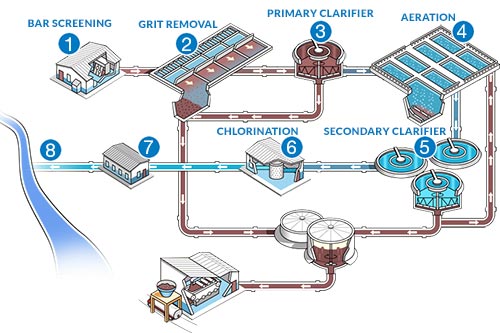Major Reasons of Upgrading Your Current Wastewater Treatment System
Major Reasons of Upgrading Your Current Wastewater Treatment System
Blog Article
Understanding Wastewater Treatment Processes and Their Environmental Influence
The ins and outs of wastewater treatment processes play a critical role in mitigating environmental challenges linked with water air pollution. Each phase, from initial to sophisticated treatments, is developed to address specific contaminants, inevitably guarding both public wellness and water communities.
Summary of Wastewater Treatment
Just how is wastewater changed into a safe source for the atmosphere? Wastewater treatment is a crucial procedure created to eliminate contaminants from made use of water, consequently securing public health and shielding ecological communities. This process begins with the collection of wastewater from residential, commercial, and industrial resources, which is after that directed to therapy facilities.
At these facilities, numerous physical, chemical, and biological methods are used to treat the wastewater. Initial testing removes huge debris, followed by sedimentation to different heavier solids. Ultimately, organic treatments, such as triggered sludge processes, make use of microorganisms to damage down raw material. These techniques not only lower toxin levels yet additionally facilitate the recovery of beneficial nutrients.
The treated effluent can be safely released right into natural water bodies or reused for watering and commercial purposes, promoting source preservation. Additionally, the treatment procedure creates biosolids, which can be repurposed as plant foods or soil changes, additionally boosting sustainability.
Stages of Treatment Processes
The wastewater treatment procedure generally consists of 3 key phases: initial, primary, and additional therapy. Each phase offers a distinctive role in reducing the pollutant load and making sure the effluent fulfills ecological criteria prior to discharge.

The primary therapy phase concentrates on the physical splitting up of put on hold solids from the wastewater. With sedimentation, much heavier bits clear up at the bottom of sedimentation storage tanks, forming sludge, while lighter materials, such as oils and oils, float to the surface area and are skimmed. This process considerably decreases the organic and not natural lots in the wastewater.
Secondary therapy is a biological procedure aimed at further minimizing the concentration of natural matter. This phase is vital for achieving the needed biochemical oxygen demand (FIGURE) reduction, inevitably leading to cleaner effluent prepared for discharge or further treatment.

Advanced Therapy Technologies
Following the additional treatment procedures, progressed therapy innovations play an essential role in additional boosting the high quality of dealt with wastewater. These innovations are created to get rid of residual contaminants that are not properly gotten rid of throughout primary and second treatments, making sure the effluent satisfies rigorous regulatory criteria.
Amongst the extensively made use of sophisticated treatment techniques are membrane layer purification, reverse osmosis, and advanced oxidation processes. Membrane filtering, consisting of microfiltration and ultrafiltration, works in separating great bits, pathogens, and colloids from the water (Wastewater). Reverse osmosis utilizes semi-permeable membranes to eliminate dissolved solids, causing high-quality water suitable for various applications
Advanced oxidation procedures (AOPs) employ solid oxidants to deteriorate organic contaminants, consisting of drugs and personal treatment products that are immune to traditional treatment. These techniques enhance the biodegradability of intricate compounds, facilitating their elimination.
An additional significant modern technology is making use of biological nutrient elimination processes, which particularly target nitrogen and phosphorus, preventing eutrophication in receiving water bodies. On the whole, innovative therapy technologies are important for achieving higher degrees of filtration, advertising water reuse, and guarding public health while dealing with the difficulties linked with wastewater management.
Ecological Advantages of Therapy
Numerous ecological benefits occur from effective wastewater therapy procedures that add to ecosystem health and wellness and sustainability. Primarily, these processes significantly decrease the launch of dangerous contaminants right into all-natural water bodies, which helps preserve marine communities. By getting rid of pollutants such as heavy steels, nutrients, and view website pathogens, dealt with wastewater mitigates the danger of waterborne illness and promotes biodiversity in marine settings.
In addition, wastewater therapy facilities typically use sophisticated modern technologies that make it possible for water recycling and reuse. This practice not only saves freshwater sources however additionally reduces the need on all-natural water materials. Boosted nutrient elimination from wastewater can likewise protect against eutrophication, a procedure that brings about algal flowers and subsequent oxygen deficiency in aquatic systems.
Furthermore, effective treatment processes can lessen greenhouse gas discharges, specifically methane and laughing gas, which are usually released throughout unattended wastewater decomposition. By recording and using biogas from anaerobic digesters, centers can transform waste right into eco-friendly power, thus adding to a decrease in fossil gas dependency.
Difficulties and Future Fads
While the dig this environmental advantages of wastewater therapy are clear, several difficulties continue that prevent optimal results in this area. One significant concern is aging facilities, which commonly leads to ineffectiveness and boosted functional prices - Wastewater. Many treatment plants were created years earlier, and their capacities do not align with modern demands, that include stricter regulative requirements and greater quantities of wastewater as a result of urbanization
Looking ahead, there is an expanding focus on resource recuperation and round economic climate principles within wastewater therapy. Advancements such as anaerobic digestion, which can produce biogas, and progressed filtering technologies are obtaining traction. These additional resources methods not just enhance treatment performance however also advertise sustainability.
Ultimately, addressing these difficulties requires partnership amongst stakeholders, investment in modern technology, and a dedication to recurring study. By welcoming these trends, the wastewater treatment market can progress to satisfy the needs of an altering setting and culture.
Verdict
In final thought, wastewater therapy processes play a vital duty in improving environmental quality and public wellness. The multi-stage therapy structure, coupled with innovative technologies, successfully reduces air pollution and promotes lasting water administration.
Report this page